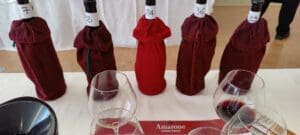Over a short spanning weekend, I had the opportunities to taste a series of wine faults (unintentionally). Regardless if one would consider these as curse or blessing, I remained sour about it. Still so today, and perhaps many weeks after. But the most incredulous thing was being told to “just accept it”.
Has it become acceptable for consumers to be presented with unappealing wines and described it as stylistic terroir expression? Or are we just blatantly condoning shoddy wine making these days?
Oxidation, reduction, “brett” and corked. You named it, I had it. While some are salvageable through further aeration, most are, unfortunately, beyond cure. Winemakers, distributors and retailers would attribute wine faults to force majeure, but – more often than not – these are due to poor facility management and wine making practices. To wrongly describe these as terroir expression is equivalent to saying “Guns don’t kill people, people do.”
Oxidation & Reduction
Oxygen keeps us alive yet also kills us slowly through the effect of oxidation. When introduced into wines, oxygen mellows harsh tannins, suffocates the fruits aroma and encourages acetic acid development. Wine making in older days often used copper for faucets and piping installations. Unknown to them, wines piped through these channels suffered from oxidation due to the accelerated reaction induced by copper. With scientific studies, most wineries have identified and done away with copper in preference for other inert material like stainless steel.
The modern proactive method of eliminating oxygen is the use of sulphur.
Nemesis of oxygen, sulphur has the natural affinity to seek, bind and halt oxygen’s disruptive nature. The use of potassium metabisulphite during harvest marks the beginning of a rigorous oxygen hunting ritual. As farmers spray the dry white powder during harvesting, the crystalline potassium metabisulphite protects the berry in a reactive fashion.
Under tremendous pressure and rough handling, the basket bottom berries break easily and let loose precious free-run juice into the gaping jaws of hungry oxygen atoms. Potassium metabisulphite, upon fluid contact, converts into sulphur dioxide readily and safeguards the freshness of precious cargo. As such, modern technology has made oxidation an inexcusable fault during wine making.
However sulphur is the cause of another fault, reduction.
Too much of anything is bad and sulphur gets nasty when they are in excess without oxygen. Giving a burning sensation in the nasal cavities that follows by sneezes is the benign effect of sulphur. Wines that smell garlicky and onion-like, or stinky armpit (ugh!) are the real deal. Malign, incurable and disgustingly unacceptable.
The other curable but no-less annoying is the smell of “rotten egg”. Unmistakable for its foulness, this fault can be dispersed only after vigorous swirling and severe amnesia. One fellow drinker, who could never get the stench of his mind after a good thirty minutes of aeration, said to me, “I can never put this in my mouth.”
Who likes rotten eggs anyway.
Brettanomyces (Brett) & Trichloranisole (TCA)
Brett and TCA are the wild west rogues of wine faults. Brett (read: brat) is generally welcome when you are a brew master. For wines, it can be a nuisance. Giving the rustic barnyard farm scent or sweaty leather, this unpredictable yeast thrives in warm climate and practically indestructible. The only prevention is regular housekeeping and thorough cleaning, ensuring a condition fitting even for hospital’s ICU ward.
Some wineries embrace Brett as part of the ecosystem. Chateau Beaucastel and Chateau Musar are among the pro-brettanomyces gang. Citing its role in wine making and expression of place, giving them the ‘edge’ over other ‘clean’ wineries in the same region. Indeed Brett suffers from splitting personality. At its best Brett gives appealing nuances of spices and bacon smokiness. At its worse, the smell of rubber bands made me question the authenticity of the wine or is this an industry-grade latex solution.
My experience with Beaucastel was enjoyable. Musar, on the other hand, was an acquired taste that I am not likely to revisit.
Trichloroanisole, with its mouldy wet cardboard bouquet, is the king of fault. TCA reduces aroma to ground zero and its phantom existence makes it difficult to manage. A by-product chemical compound, TCA comes from the metabolism by bacteria or mould with Trichlorophenol or Chlorine-related chemical product. While it is commonly known as ‘corked’, the taint can be developed on surrounding wooden furniture before infused into wine production. This environmental tainting is termed, Systemic TCA.
Their long standing influence on cork enclosed bottle had driven the industry to derive alternate means of enclosure. Screw cap enclosure was pioneered by the Swiss and championed by Aussie and Kiwis. But the excellent air tight property of aluminium screw cap increases the chance of reduction. The next innovation against TCA is the rubbery synthetic cork and the hybrid texture technical corks.
If the wild west can be controlled with modern technology and strict quality processes, why should we settle for fault?
Should we drink fault wines?
Whenever I come across a Wine Tainted by Fault (or WTF) I will undergo sense of extreme agony. In a country where wines don’t come cheaply, buying a fault wine is a heart wrenching experience. Serving faulty wines during paid event and insisting it’s okay, is a case of fraud, con and cheat that should be punished by hanged, drawn and quartered.
Most faults are developed from the source, but oxidation can develop in a sales premise. The most common occurrence is usually in an outlet where wines are served by glass. Keeping an opened bottle without proper facility to manage, couple with staff who are not well versed with wine services and you have the perfect recipe for wine fault.
No, I insist on NOT drinking fault wines regardless if it is recoverable or otherwise. With every glass that comes to my nose, I go through a check list of faults to detect. If something is amiss, I will let it sit on the table since fault will be more prominent with higher temperature and oxygen exposure.
If the scent persists, requests for a change. If no change is entertained, curses the outlet and posts it on social media.
And drop me an email at this.is@winexin.sg.



